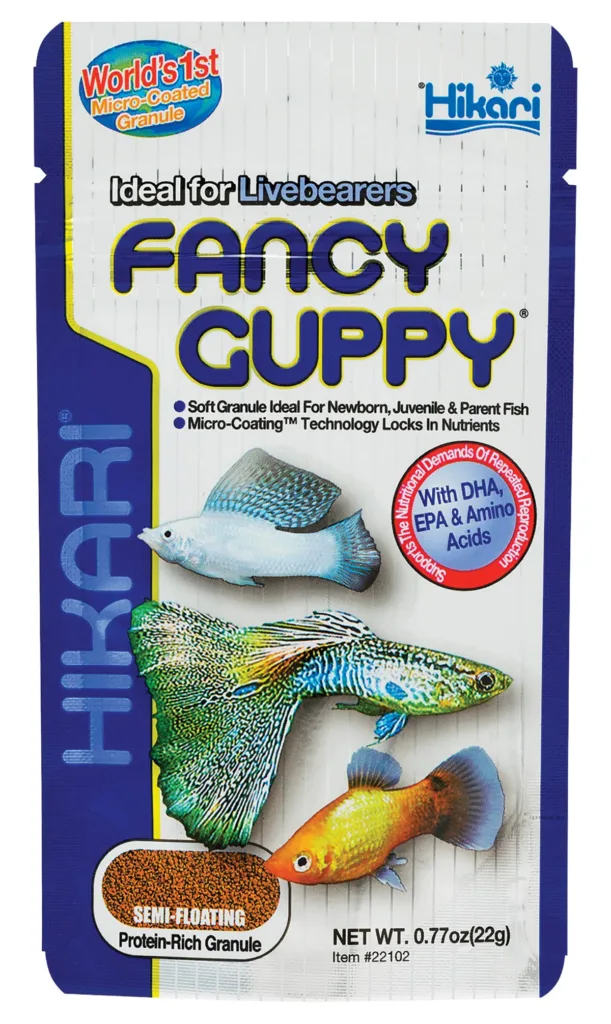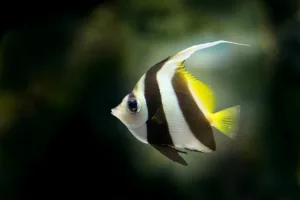The swamp guppy, also known as the picta swamp guppy (Micropoecilia picta), is a small livebearing fish native to South America. It is found in a variety of habitats, including freshwater streams, brackish estuaries, and even small lakes. Swamp guppies are relatively small fish, with males reaching a maximum size of about 1.2 inches and females reaching 1.5 inches. They are typically drab in color, with males having some red and black markings on their bodies and fins.
Swamp guppies are relatively easy to care for in the aquarium, but they do require some special considerations. They prefer slightly brackish water, so a specific gravity of 1.005 to 1.010 is ideal. The water temperature should be between 78 and 82 degrees Fahrenheit. Swamp guppies are also relatively sensitive to water quality, so regular water changes are essential.
Origin
The swamp guppy (Micropoecilia picta) is native to South America, where it is found in a variety of habitats, including freshwater streams, brackish estuaries, and even small lakes. Its range extends from Trinidad and Tobago to the Amazon River delta.
Swamp guppies are thought to have evolved from a common ancestor with the guppy (Poecilia reticulata), which is also native to South America. However, the two species are not closely related, and they differ in a number of ways. For example, swamp guppies are smaller than guppies, and they have a different body shape. Swamp guppies are also more tolerant of brackish water than guppies.
Swamp guppies are an important part of the ecosystems they inhabit. They are a food source for many larger fish, birds, and reptiles. They also help to control mosquito populations by eating mosquito larvae.

Appearance and size:
Swamp guppies are small, slender fish with a streamlined body shape. Males typically reach a maximum size of about 1.2 inches (3 cm) in length, while females can reach up to 1.5 inches (4 cm).
Swamp guppies are typically drab in color, with males having some red and black markings on their bodies and fins. Females are even more drab, with a silvery-green body and a few dark spots.
However, there is also a red color morph of the swamp guppy, which is more popular in the aquarium hobby. Red swamp guppies have a bright orange-red body with some black spots.
Swamp guppies are often confused with guppies (Poecilia reticulata), but there are a few key differences between the two species. Swamp guppies are smaller than guppies, and they have a different body shape. Swamp guppies are also more tolerant of brackish water than guppies.
Care Guide
Setting up the tank for swamp guppies
To set up a tank for swamp guppies, you will need the following equipment:
- A 10-gallon aquarium or larger
- A filter
- A heater
- A thermometer
- A hydrometer
- Aquarium gravel
- Live plants
- Decorations (optional)
Once you have all of your equipment, you can begin setting up the tank:
- Rinse the aquarium gravel thoroughly to remove any dust or debris.
- Add the aquarium gravel to the bottom of the tank.
- Add the live plants to the tank.
- Fill the tank with water.
- Add the filter and heater to the tank.
- Set the filter and heater to the appropriate settings.
- Add the decorations to the tank (optional).
- Allow the tank to cycle for at least two weeks before adding any fish.
Once the tank has cycled, you can add your swamp guppies to the tank. It is important to add the fish slowly to avoid overwhelming the filter.
Here are some additional tips for setting up a tank for swamp guppies:
- Swamp guppies prefer a slightly brackish water environment. To achieve this, you can add a marine salt mix to your freshwater aquarium. The specific gravity of the water should be between 1.005 and 1.010.
- Swamp guppies are also relatively sensitive to water quality, so regular water changes are essential. A good rule of thumb is to change 25% of the water every week.
- Swamp guppies are relatively small fish, so a 10-gallon aquarium is sufficient for a small group of fish. However, if you are planning on breeding swamp guppies, you will need a larger aquarium.
- The aquarium should be planted with live plants, which will provide the fish with hiding places and help to improve water quality. Some good plants for swamp guppies include Java fern, Amazon swordplant, and Anubias.
Swamp guppies prefer a slightly brackish water environment, so a specific gravity of 1.005 to 1.010 is ideal. You can achieve this by adding a marine salt mix to your freshwater aquarium. The water temperature should be between 78 and 82 degrees Fahrenheit.
Swamp guppies are also relatively sensitive to water quality, so regular water changes are essential. A good rule of thumb is to change 25% of the water every week.
Swamp guppies are relatively small fish, so a 10-gallon aquarium is sufficient for a small group of fish. However, if you are planning on breeding swamp guppies, you will need a larger aquarium.
The aquarium should be planted with live plants, which will provide the fish with hiding places and help to improve water quality. Some good plants for swamp guppies include Java fern, Amazon swordplant, and Anubias.

Feeding guide for swamp guppies
Swamp guppies are omnivores and should be fed a varied diet of flake food, frozen foods, and live foods.
Here are some good foods to feed swamp guppies:
- Flake food: Flake food should be a staple of the swamp guppy’s diet. Choose a high-quality flake food that is specifically formulated for guppies.
- Frozen foods: Frozen foods are a great way to provide swamp guppies with a variety of nutrients. Some good frozen foods for swamp guppies include brine shrimp, bloodworms, and daphnia.
- Live foods: Live foods are a natural part of the swamp guppy’s diet. Some good live foods for swamp guppies include brine shrimp, bloodworms, and daphnia.

It is important to feed swamp guppies twice a day, only as much food as they can eat in a few minutes. Overfeeding can lead to water quality problems and health issues for the fish.
Here is a sample feeding schedule for swamp guppies:
- Morning: Flake food
- Evening: Frozen foods or live foods
You can also supplement the swamp guppy’s diet with algae wafers or a vegetable-based flake food. However, these foods should not be the staple of the diet.
It is also important to note that swamp guppies are more sensitive to water quality than other types of guppies. Therefore, it is important to test the water regularly and make sure that it is clean and within the appropriate parameters.
Diseases and how to treat swamp guppies
Swamp guppies are relatively hardy fish, but they are still susceptible to some common fish diseases. Some of the most common diseases that can affect swamp guppies include:
- Ich: Ich is a parasitic disease that causes white spots to appear on the fish’s body and fins. Ich can be treated by raising the water temperature to 82 degrees Fahrenheit and adding an ich medication to the water.
- Fin rot: Fin rot is a bacterial infection that causes the fish’s fins to become ragged and frayed. Fin rot can be treated by adding an antibiotic medication to the water.
- Velvet: Velvet is a parasitic disease that causes a golden or rusty-colored dust to appear on the fish’s body and fins. Velvet can be treated by adding a copper medication to the water.
If you notice any signs of disease in your swamp guppies, it is important to isolate the affected fish and treat them immediately.
Tank mates for swamp guppies
Swamp guppies are relatively peaceful fish and can be kept with other small, peaceful fish. Some good tank mates for swamp guppies include:
- Neon tetras
- Guppies
- White cloud mountain minnows
- Zebra danios
- Rosy barbs
- Corydoras catfish
However, it is important to avoid keeping swamp guppies with larger or more aggressive fish, as they can be bullied.
Breeding
Swamp guppies are relatively easy to breed in the aquarium. The females are livebearers, meaning they give birth to live young.
To breed swamp guppies, you will need a separate breeding tank. This tank should be at least 10 gallons in size and should be planted with live plants. The water temperature should be between 78 and 82 degrees Fahrenheit.
Once the breeding tank is set up, you can add a pair of swamp guppies. The male will court the female by swimming around her and displaying his fins. If the female is receptive, she will allow the male to fertilize her eggs.
The female will carry the fertilized eggs for about 28 days before giving birth. The fry are very small and should be fed infusoria or baby brine shrimp until they are large enough to eat flake food.
It is important to remove the adult swamp guppies from the breeding tank after the female gives birth, as they may eat the fry.
Here are some tips for breeding swamp guppies:
- Make sure the breeding tank is well-maintained and has good water quality.
- Feed the adult swamp guppies a high-quality diet to ensure that they are in good health.
- Remove the adult swamp guppies from the breeding tank after the female gives birth.
- Feed the fry a nutritious diet and keep the water clean.
With proper care, you should be able to breed swamp guppies successfully.
Where to buy and average cost
You can buy swamp guppies from a variety of sources, including:
- Local fish stores: Many local fish stores sell swamp guppies. However, it is important to call ahead to make sure that they have them in stock.
- Online retailers: There are a number of online retailers that sell swamp guppies. However, it is important to choose a reputable retailer to ensure that you receive healthy fish.
The average price of a swamp guppy is between $5 and $10. However, the price may vary depending on the quality of the fish and the retailer you purchase them from.
Here are some tips for buying swamp guppies:
- Inspect the fish carefully before purchasing them. Make sure that they are healthy and active.
- Ask the retailer about the fish’s diet and water quality requirements.
- Be sure to quarantine the new fish before adding them to your main aquarium.









